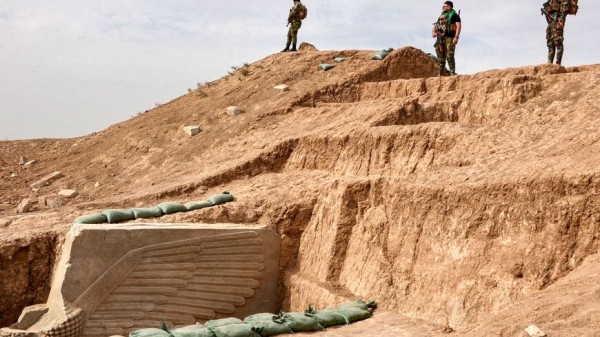
Iraqi security forces stand guard at the site of a newly-unearthed Assyrian lamassu (human-headed winged bull) sculpture discovered with its entire wings intact by the French archaeological mission at the archaeological site of Khorsabad (also known as Dur-Sharrukin), the former Assyrian capital in the time of Sargon II (721-705 BCE) in Iraq's northern Nineveh province on Oct. 24, 2023. - ZAID AL-OBEIDI/AFP via Getty Images
Ishtartv.com - al-monitor.com
October 24, 2023, Adam Lucente
Iraqi authorities on Tuesday unveiled an ancient Assyrian statue as the
government continues to work on preserving the country’s rich archaeological
heritage.
The General Authority for Antiquities and Heritage said the excavation
of the lamassu took place in Khorsabad, north of Mosul in the Nineveh province.
The structure was first discovered in 1992 by an Iraqi excavation team. Its
head was stolen in 1995, but was then recovered and placed in the Iraqi
National Museum in Baghdad, where it remains. The remaining structure was
reburied for preservation, the authority said in a Facebook post.
The authorities did not specify when exactly the structure was reburied
nor when the head was brought to the museum. A joint Iraqi-French team working
on excavations in Khorsabad is assessing the lamassu's condition, according to
the post.
What it means: The lamassu is an Assyrian protective deity that dates
back to ancient Mesopotamia. It is often depicted with a human head, the body
of a lion, bull or related animal, and wings. Assyrian kings placed them in
their domains as a form of protection.
The lamassu excavated on Tuesday dates back to the Neo-Assyrian era,
specifically the reign of Sargon II from 722-705 BCE, according to the
authority. Khorsbad is known for its statues of lamassus.
Why it matters: The Iraqi government has been working on preserving the
country’s archaeological heritage in recent years, particularly recovering
stolen antiquities. The Iraqi National Museum reopened last year after the
successful repatriation of thousands of artifacts that were smuggled out of
Iraq.
The lamassu in Khorsabad survived the war with the Islamic State, aka
ISIS, as the group razed parts of the city in 2015. ISIS destroyed ancient,
non-Islamic heritage sites throughout the region after its rise to power in
2014, perhaps most notably in Palmyra, Syria.
|